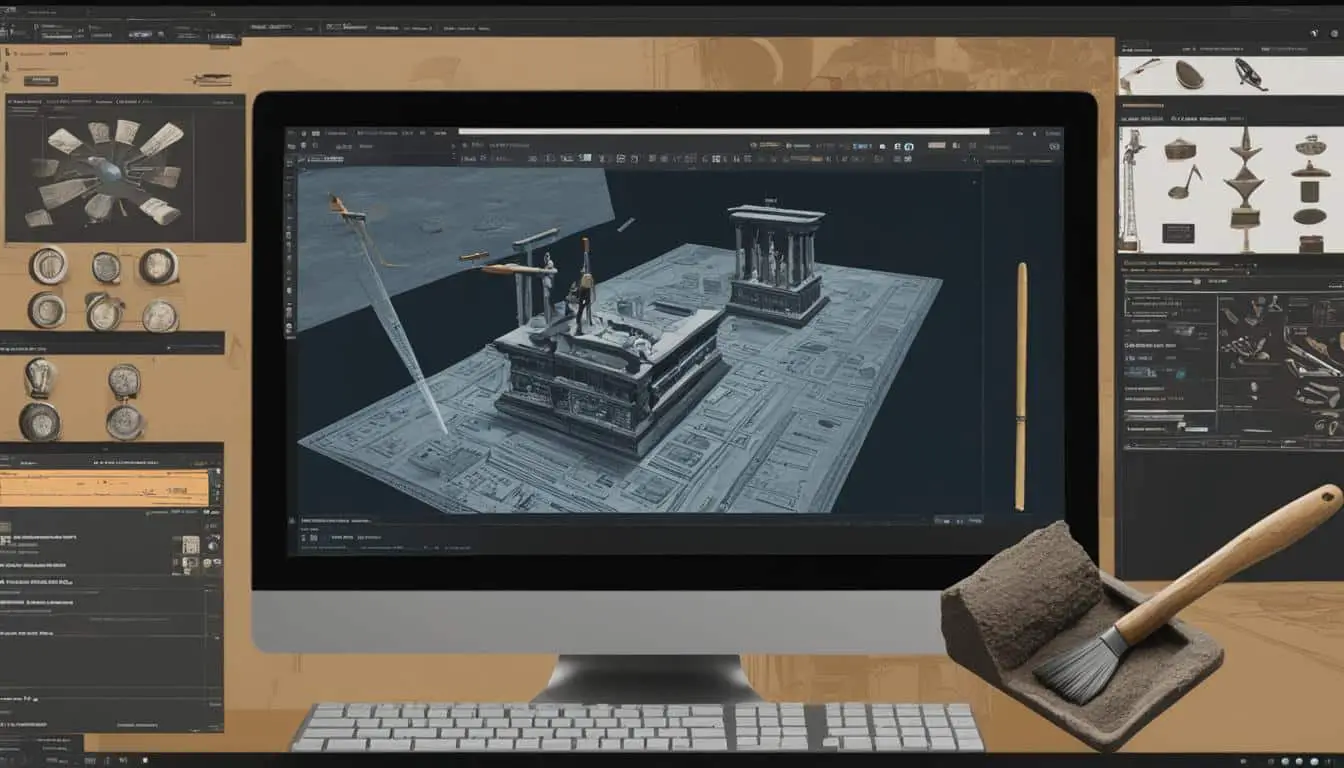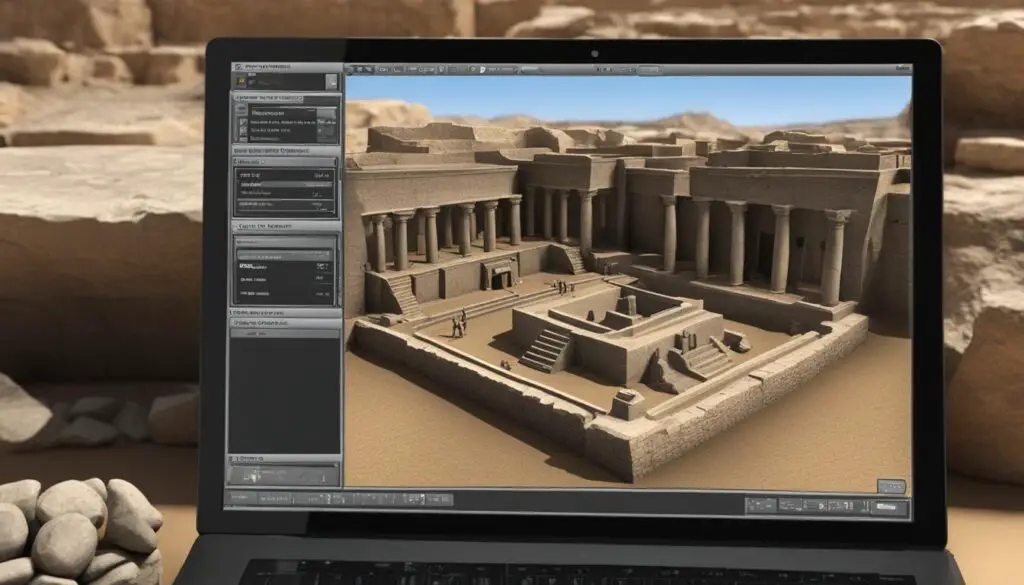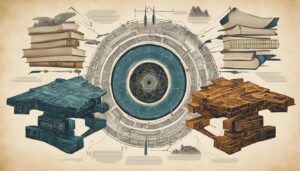
Computer modeling is revolutionizing the field of biblical archaeology research, allowing me to uncover ancient mysteries with the help of cutting-edge technology. By harnessing the power of computers and sophisticated algorithms, I am able to create virtual reconstructions of archaeological sites, analyze data, and make educated interpretations about the past. This innovative approach has significantly enhanced our understanding of biblical narratives and the historical context in which they unfolded. Through computer modeling, I can visualize ancient structures, conduct virtual excavations, and gain insights into the lives of people who lived thousands of years ago.
Key Takeaways:
- Computer modeling is transforming biblical archaeology research by utilizing technology to analyze and interpret the past.
- This approach allows for the creation of virtual reconstructions, virtual excavations, and visualization of ancient structures.
- Computer modeling enhances our understanding of biblical narratives and the historical context in which they occurred.
- Virtual reconstructions provide valuable insights into the lives of people who lived thousands of years ago.
- Computer modeling allows researchers to simulate scenarios, test hypotheses, and save time and resources on physical excavations.
The Advantages of Computer Modeling in Biblical Archaeology Research
Computer modeling has emerged as a powerful tool in the field of biblical archaeology research, offering numerous advantages that transform the way we explore and understand ancient civilizations. By harnessing the capabilities of advanced computational algorithms and immersive digital environments, researchers can unlock insights that were once unimaginable, paving the way for groundbreaking discoveries. In this section, we will delve into the key advantages of computer modeling in biblical archaeology research.
1. Simulation and Hypothesis Testing
One of the primary advantages of computer modeling is its ability to simulate different scenarios and test hypotheses without the need for physical excavation. Researchers can create virtual reconstructions of sites, structures, and artifacts, allowing them to explore various possibilities and gain a deeper understanding of the past. By manipulating variables and parameters within the model, they can analyze the potential outcomes and refine their interpretations, saving valuable time and resources.
2. Accurate Visual Representations
Computer modeling provides researchers with more accurate visual representations of ancient structures, enabling detailed analysis and precise measurements. Through 3D modeling and rendering techniques, these digital replicas breathe life into archaeological remains, allowing researchers to observe intricate details and uncover hidden insights. By studying the virtual reconstructions, they can examine architectural features, spatial organization, and material composition, enhancing our understanding of the biblical world.
3. Environmental Impact Analysis
Computer modeling allows researchers to study the impact of environmental factors on archaeological sites and make predictions about how they may have changed over time. By integrating geological, climatic, and topographical data into the models, researchers can simulate the effects of natural phenomena such as erosion, tectonic movements, or changes in sea levels. This holistic approach provides valuable insights into the evolution of ancient landscapes and the interactions between humans and their environment, enriching our interpretations of biblical narratives.
4. Enhanced Data Interpretation
The use of computer modeling enables researchers to interpret archaeological remains in a more informed manner. By integrating various data sources, such as excavation records, historical documents, and scientific analyses, into the models, researchers can synthesize information and gain a comprehensive understanding of the context in which artifacts were used. This interdisciplinary approach allows for a more nuanced interpretation of the material culture and societal dynamics of ancient civilizations, contributing to our broader knowledge of biblical times.
“Computer modeling has revolutionized the field of biblical archaeology research, giving us unprecedented opportunities to explore the mysteries of the past.”
Overall, the advantages of computer modeling in biblical archaeology research are vast. From simulation and hypothesis testing to accurate visual representations and environmental impact analysis, this innovative approach enhances our understanding of the biblical world. Furthermore, computer modeling provides a powerful tool for data interpretation, enabling researchers to unravel the complexities of ancient civilizations. As technology continues to advance, the potential for computer modeling in biblical archaeology research appears boundless, opening up new horizons for exploration and discovery.
Applications of Computer Modeling in Biblical Archaeology Research
Computer modeling plays a pivotal role in biblical archaeology research, offering various applications that enhance our understanding of the ancient world. By utilizing historical data, archaeological evidence, and advanced modeling techniques, researchers can unlock valuable insights into the architectural features, spatial organization, and cultural significance of ancient cities and buildings.
One of the primary uses of computer modeling in biblical archaeology research is the virtual reconstruction of ancient structures. Through the combination of accurate data and sophisticated algorithms, researchers can recreate architectural wonders that have been lost to time. These virtual reconstructions provide a vivid representation of the ancient world, allowing us to explore the intricate details of these structures and gain a deeper understanding of their historical context.
In addition to virtual reconstructions, computer modeling also aids in the analysis and interpretation of artifact distributions. By inputting data on artifact findings into computer models, researchers can identify patterns and establish connections between different archaeological sites. This analysis enables us to unravel the complexities of ancient trade networks, social interactions, and cultural practices, shedding light on the daily lives of people in biblical times.
Furthermore, computer simulations enable researchers to study the impact of natural phenomena and human activities on the development of ancient settlements. By inputting data on environmental factors such as climate, geography, and resources, computer models can recreate the conditions under which these settlements thrived or declined. This helps us understand how factors like erosion, land use, and natural disasters shaped the landscapes and influenced the decisions of ancient societies.

Computer modeling has become an indispensable tool in biblical archaeology research, providing researchers with the ability to explore, analyze, and visualize the ancient world in ways that were previously unimaginable. From accurate virtual reconstructions of ancient structures to the analysis of artifact distributions and the study of ancient landscapes, computer modeling unlocks the secrets of the past and enriches our understanding of biblical history.
Challenges and Limitations of Computer Modeling in Biblical Archaeology Research
While computer modeling has revolutionized biblical archaeology research, it is not without its challenges and limitations. Let’s explore some of the key obstacles that researchers face when utilizing computer modeling in this field.
Data Accuracy and Validation
One of the main challenges in computer modeling for biblical archaeology research is ensuring accurate data input. The quality and quantity of available archaeological data can vary significantly, requiring researchers to carefully evaluate and validate the information used in their models. Data inaccuracies or omissions can have a significant impact on the reliability and validity of the results.
Subjectivity in Interpretation
Another limitation of computer modeling in biblical archaeology research lies in the inherent subjectivity of interpreting archaeological evidence. While computer models rely on human decisions and assumptions, these subjective factors can introduce bias into the analysis. Researchers must exercise caution and transparency in their interpretations to ensure the accuracy and reliability of their findings.
Technical Expertise and Accessibility
Computer modeling in biblical archaeology research requires a high level of technical expertise, which can pose limitations for researchers who may not have the necessary skills or resources to effectively utilize this technology. Access to advanced computational tools, software, and training may be limited, creating barriers for some individuals and organizations in conducting computer modeling research.
“The accuracy and reliability of computer modeling in biblical archaeology research depend greatly on the quality and validation of the data used, the transparency of interpretations, and the technical expertise of the researchers involved.”
Despite these challenges and limitations, computer modeling continues to be a valuable tool in biblical archaeology research. Through continuous advancements in data collection, modeling techniques, and interdisciplinary collaborations, researchers are working towards minimizing these challenges and maximizing the potential of computer modeling in uncovering the mysteries of the ancient biblical world.
| Challenges | Impact |
|---|---|
| Data accuracy and validation | Reliability and validity of results |
| Subjectivity in interpretation | Potential introduction of bias |
| Technical expertise and accessibility | Limited utilization of technology |
Despite these challenges, computer modeling remains a powerful tool that contributes to our understanding of biblical narratives and the historical context in which they unfolded.

Case Studies: Unveiling Ancient Mysteries Through Computer Modeling
Several notable case studies highlight the power of computer modeling in biblical archaeology research. By leveraging this innovative technology, researchers have made significant breakthroughs in unraveling ancient mysteries and shedding light on the historical context of biblical narratives. Let’s explore two fascinating case studies that demonstrate the potential of computer modeling in biblical archaeology research.
Reconstructing the Ancient City of Jerusalem
One compelling case study that showcases the capabilities of computer modeling is the study of the ancient city of Jerusalem. Through computer modeling, researchers have been able to reconstruct the city’s historical evolution, visualize its changing topography, and explore its spatial organization. By analyzing archaeological data, historical records, and advanced modeling techniques, a virtual reconstruction of ancient Jerusalem comes to life, providing invaluable insights into the layout of the city and the lives of its inhabitants.
A virtual reconstruction of ancient Jerusalem created through computer modeling.
Analyzing Artifact Distributions at Tel Megiddo
Another intriguing case study involves the analysis of artifact distributions at the site of Tel Megiddo. Computer modeling has enabled researchers to examine patterns in the distribution of artifacts, offering valuable insights into ancient trade networks and economic activities. By inputting data from excavations and employing sophisticated algorithms, computer models can simulate the movement of artifacts over time, shedding light on the interconnectedness of ancient civilizations and providing a deeper understanding of the biblical world.
| Case Study | Key Findings |
|---|---|
| Reconstructing the Ancient City of Jerusalem |
|
| Analyzing Artifact Distributions at Tel Megiddo |
|
These case studies exemplify how computer modeling can complement traditional archaeological methods and contribute to a more comprehensive understanding of the biblical world. By harnessing the power of technology, researchers can unlock ancient mysteries, simulate historical scenarios, and gain unprecedented insights into the lives of people who lived thousands of years ago.
Future Directions: The Potential of Computer Modeling in Biblical Archaeology Research
The field of biblical archaeology research is on the brink of an exciting future, thanks to the advancements in computer modeling technology. As we continue to push the boundaries of what is possible, researchers are increasingly exploring new applications and techniques to enhance their models and analyses.
One of the key areas of focus for future development is the integration of data from various sources, such as satellite imagery and LiDAR scans. By incorporating these rich datasets, researchers can create more detailed and accurate virtual reconstructions of ancient sites. This integration of data allows for a deeper understanding of the architectural features, spatial organization, and the overall context in which biblical narratives unfolded. These enhanced reconstructions have the potential to reshape our understanding of ancient biblical civilizations.
Another exciting direction in computer modeling is the utilization of artificial intelligence (AI) and machine learning algorithms. AI has the potential to automate certain aspects of the modeling process, optimizing efficiency and reducing human bias. By leveraging these technologies, researchers can analyze vast amounts of data and identify patterns that may not be immediately apparent to the human eye. This revolutionary approach can lead to new discoveries and insights in biblical archaeology research.
Furthermore, the future of computer modeling in biblical archaeology research holds great potential for interdisciplinary collaborations. By bringing together experts from various fields, including archaeology, computer science, and geology, we can expand the scope and depth of our models. Collaborative efforts can lead to more comprehensive analyses of ancient landscapes, cultural practices, and social dynamics.
In summary, the future of computer modeling in biblical archaeology research is indeed promising. By integrating diverse datasets, leveraging the power of AI, and fostering interdisciplinary collaborations, researchers are poised to unlock new avenues of exploration and discovery. As we continue to push the boundaries of technology, the potential for computer modeling to shed light on ancient mysteries and enrich our understanding of the biblical narrative is limitless.
| Future Directions of Computer Modeling in Biblical Archaeology Research | Potential Benefits |
|---|---|
| Integration of data from various sources | – More detailed and accurate virtual reconstructions – Enhanced understanding of architectural features and spatial organization |
| Utilization of artificial intelligence and machine learning algorithms | – Automation of modeling process – Reduction of human bias – Identification of hidden patterns and insights |
| Interdisciplinary collaborations | – Comprehensive analyses of ancient landscapes and cultural practices – Deeper understanding of social dynamics in biblical civilizations |
Ethical Considerations in Computer Modeling for Biblical Archaeology Research
The use of computer modeling in biblical archaeology research raises important ethical considerations. One key concern is the potential for the misinterpretation or misuse of virtual reconstructions. While computer models can provide valuable insights, they are still based on interpretations and assumptions, which may not always be accurate. Researchers must be transparent about the limitations and uncertainties of their models and avoid presenting them as definitive truth.
Another ethical consideration is the accessibility of computer modeling technology. Efforts should be made to make this technology more widely available to researchers around the world, ensuring equitable access to the tools and resources necessary for meaningful archaeological investigations. By promoting inclusivity and collaboration, the field can benefit from diverse perspectives and enhance the overall quality of research.
It is also important to consider the potential impact of computer modeling on local communities and cultural heritage. Researchers should engage with local stakeholders and communities to ensure that their work respects and preserves the sacredness and significance of archaeological sites. This includes obtaining informed consent, addressing concerns of cultural appropriation, and minimizing any potential harm caused by the research.
“With great power comes great responsibility.”
Computer modeling has the power to revolutionize biblical archaeology research, but it is essential to approach it ethically and responsibly. By acknowledging the limitations, promoting accessibility, and engaging with local communities, researchers can contribute to a more inclusive and ethical practice of computer modeling in biblical archaeology research.
Conclusion
Computer modeling has undoubtedly revolutionized biblical archaeology research, enabling us to gain new insights and perspectives into the ancient world. Through the power of technology, researchers can reconstruct ancient cities, analyze artifact distributions, and explore the dynamics of ancient landscapes.
However, it is important to acknowledge the challenges and limitations of computer modeling in this field. Accurate data input and the subjective nature of interpretation can pose obstacles to achieving accurate results. Furthermore, technical expertise and resources are necessary to effectively utilize computer modeling tools.
Despite these challenges, when approached with caution and a critical mindset, computer modeling has the potential to continue unveiling ancient mysteries and contributing to our understanding of the biblical narrative. By combining the strengths of computer modeling with traditional archaeological methods, we can paint a clearer picture of the past and continue to deepen our knowledge of ancient civilizations.
FAQ
What is computer modeling in biblical archaeology research?
Computer modeling is a cutting-edge technology that allows researchers to create virtual reconstructions of archaeological sites, analyze data, and make educated interpretations about the past using computers and sophisticated algorithms.
What are the advantages of computer modeling in biblical archaeology research?
Computer modeling offers numerous advantages, including the ability to simulate scenarios and test hypotheses without physical excavation, provide accurate visual representations of ancient structures, and study the impact of environmental factors on archaeological sites.
How is computer modeling used in biblical archaeology research?
Computer modeling is used to reconstruct ancient cities and buildings, analyze and interpret artifact distributions, and study ancient landscapes to gain insights into the architectural features, cultural significance, and development of ancient settlements.
What are the challenges and limitations of computer modeling in biblical archaeology research?
Challenges include the need for accurate data input and the subjective interpretation of archaeological evidence. Limitations include the technical expertise required and the potential for bias introduced by human decisions and assumptions.
Can you provide examples of computer modeling in biblical archaeology research?
Sure! Computer modeling has been used to reconstruct the historical evolution of the ancient city of Jerusalem and analyze artifact distributions at the site of Tel Megiddo, offering valuable insights into spatial organization, trade networks, and economic activities.
What is the future of computer modeling in biblical archaeology research?
As technology continues to advance, researchers are exploring new applications and techniques, such as the integration of data from various sources and the development of artificial intelligence and machine learning algorithms, to further enhance their models and analyses.
What are the ethical considerations in computer modeling for biblical archaeology research?
Ethical considerations include the potential for misinterpretation or misuse of virtual reconstructions, the need for transparency about the limitations and uncertainties of models, and ensuring equitable access to computer modeling technology for researchers around the world.
What is the significance of computer modeling in biblical archaeology research?
Computer modeling has revolutionized the field by offering new insights and perspectives into the ancient world, helping researchers study and interpret biblical narratives, reconstruct ancient structures, and explore the dynamics of ancient landscapes.








